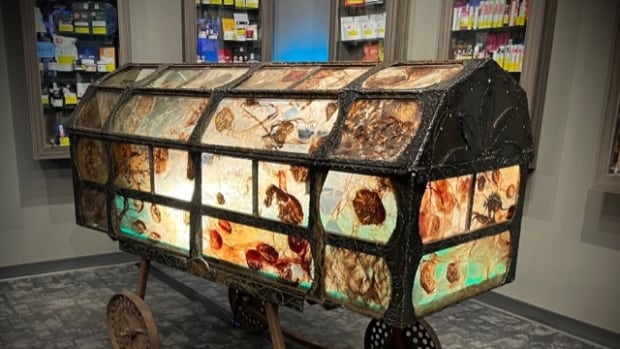When customers enter the Dawson Creek Cannabis Company store to buy marijuana, some are stopped dead in their tracks by what looks like a full-sized, glowing coffin in the middle of the store.
Illuminated from within, it looks like a stained-glass casket.
But it’s actually a work of art crafted from cow placentas, created by local rancher and artist Emilie Mattson.
“It raises eyebrows,” said Mattson in an interview with CBC News about creating art from afterbirth. “It makes a bit of a spark. Some people are totally disgusted and walk away, horrified. Some are amazed.”
Mattson said she was first inspired to use the unusual artistic medium during calving season at her ranch near Rolla, B.C., more than 20 years ago.
Helping to deliver a calf in her barn in bitterly cold weather, she slung the placenta over a light at the edge of the stall.
“We’re helping this cow because she’s having trouble, and I look over and with the light behind it, the placenta looks like stained glass,” she recalled.
At the time, Mattson was running 300 head of cattle and raising a family on the farm, but was already an artist working in paint and sculpture.
She soon began to experiment with adding preserved placenta to her repertoire. Preserved in a special brine, she says placenta dries like parchment or leather, preserving dramatic colours.

Calving season gave her a plentiful supply. While she said her neighbours in ranch country were dismissive at first, they eventually started saving the placentas of their own animals and “brought them over in buckets” to top up her supplies.
Even the local veterinarian contributed, she said.
Mattson has since used placentas in many of her multimedia pieces.
For the coffin-shaped work she calls The Treasure Box, which took her two years to make, she stretched placenta across a metal frame that’s held up by a well worn chassis.
Now it’s been given pride of place in a cannabis dispensary a 20-minute drive from her ranch.
Dawson Creek Cannabis Company owner Matthew Rivard, who promotes local artists in his store, says Mattson’s artwork is “captivating, breathtaking, and with brilliant colours.”

He says the piece is eye-opening for locals who come in to buy a pre-rolled joint or THC gummies.
“You definitely see customers come in, people that are just getting off of work. Maybe they’re working down at the tire shop and they come in and they stop and they look at the piece and say, ‘Oh my God.’ Everybody has a reaction.
“They think it’s stained glass, and then they take a closer look. They see a little fleck of straw in the placenta. Some are like, ‘Oh yeah, I can see life and death.'”
Mattson’s art, including more conventional painting, has been exhibited in juried exhibitions for years.
Her art has been reviewed in publications as wide ranging as Beef in B.C. — a B.C. Cattlemen’s Association magazine — and the culture periodical Espace Sculpture.
“These brilliantly coloured afterbirths are both a symbol and a chore,” wrote art critic Paula Gustafson in Espace Sculpture in 2001, reviewing one of Mattson’s placenta pieces at the Artropolis 2001 show held at the CBC Vancouver studios.
“[They represent] … the miracle and mystery of birth and the sacred and violent act of labour.”
For Mattson, the placenta, which nourishes the baby in the womb, is “the beginning of everything.”
“It’s life sustaining. … If it wasn’t for the placenta, we wouldn’t exist,” she said.


